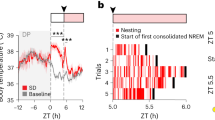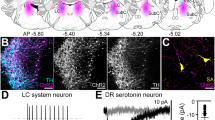Abstract
BRIEF stimulation of the marine mollusc Aplysia by food elicits an arousal response that is in many ways analogous to arousal seen in vertebrates. Animals assume a characteristic ‘orientating’ posture, and the speed and strength of successive biting responses progressively increase1. In addition, food arousal is associated with an acceleration of heart rate2 and modification of defensive reflexes3. Several lines of evidence suggest that arousal in vertebrates may be mediated by biogenic amines, acting to alter neuronal excitability through an effect involving stimulation of cyclic adenosine monophosphate (cAMP)4–6. Previous studies have indicated that activity of a pair of identified serotonergic cells (the metacerebral cell, MCC) in Aplysia and other gastropod molluscs can produce both peripheral and central effects associated with modifications of the biting response during food arousal6–11. Thus, for example, in Aplysia, firing of an MCC enhances the contractility of the accessory radular closer muscles, muscles involved in the biting response; MCC firing also increases the frequency of the rhythmic burst output from the buccal ganglion which controls the biting and swallowing phases of feeding6,11. The effects of the MCC seem to be due to the release of serotonin at its central and peripheral terminals. Because of the actions of serotonin in mediating aspects of arousal of feeding behaviour6,12 and perhaps sensitisation of other reflexes in Aplysia11,14,18, it has been suggested that serotonin may act in a way analogous to that of epinephrine and other biogenic amines in the central and peripheral effects associated with the arousal of vertebrates5,12,13. Possible evidence for the involvement of the biogenic amines in arousal and sensitisation is the ability of these compounds to stimulate the synthesis of cAMP and thereby to produce relatively long-lasting effects in excitable tissue. Several observations are consistent with the hypothesis that the action of the MCC at buccal muscle may involve a second messenger, such as cAMP11,15; these are that the onset and decay of the effects of the MCC are remarkably slow for synaptic transmission, that the action of the MCC and serotonin in buccal muscle seems to involve an unusual neurotransmitter mechanism in which there is no alteration in the resting membrane potential, and that phosphodiesterase-resistant analogues of cAMP simulate the action of the MCC on buccal muscle. We provide evidence here that food arousal in Aplysia may also involve the action of a biogenic amine acting to increase cAMP levels, and we show that the application of serotonin or the firing of an identified serotonergic neurone enhances the synthesis of cAMP in muscles involved in the biting response.
This is a preview of subscription content, access via your institution
Access options
Subscribe to this journal
Receive 51 print issues and online access
$199.00 per year
only $3.90 per issue
Buy this article
- Purchase on Springer Link
- Instant access to full article PDF
Prices may be subject to local taxes which are calculated during checkout
Similar content being viewed by others
References
Susswein, A. J., Weiss, K. R. & Kupfermann, I. J. comp. Physiol. (in the press).
Dieringer, N., Koester, J. & Weiss, K. R. J. comp. Physiol. (in the press).
Advokat, C., Carew, T. & Kandel, E. Abstr. Soc. Neurosci. 2, 313 (1976).
Bolme, P., Fuxe, K. & Lidbrink, P. Res. Commun. chem. path. Pharmac. 4, 657–697 (1972).
Mansour, T. E. & Stone, D. B. Biochem. Pharmac. 19, 1137–1146 (1970).
Weiss, K. R., Cohen, J. & Kupfermann, I. Brain Res. 99, 381–386 (1975).
Berry, M. S. & Pentreath, V. W. J. exp. Biol. 65, 361–380 (1976).
Gillette, R. & Davis, W. J. J. comp. Physiol. 116, 129–159 (1977).
Granzow, B. & Kater, S. B. Neuroscience (in the press).
Prior, D. J. & Gelperin, A. J. comp. Physiol. 114, 217–232 (1977).
Weiss, K. R., Cohen, J. L. & Kupfermann, I. J. Neurophysiol. 41, 181–203 (1978).
Weiss, K. R. & Kupfermann, I. Soc. Neurosci. Symp. 3, (in the press).
Kandel, E. R., Brunelli, M., Byrne, J. & Castellucci, V. Cold Spring Harb. Symp. quant. Biol. 40, 465–482 (1976).
Mayeri, E., Koester, J., Kupfermann, I., Liebeswar, G. & Kandel, E. R. J. Neurophysiol. 37, 458–475 (1974).
Weiss, K. R., Schonberg, M., Cohen, J., Mandelbaum, D. & Kupfermann, I. Abstr. Soc. Neurosci. 2, 338 (1976).
Salomon, Y., Londos, C. & Rodbell, M. Analyt. Biochem. 58, 541–548 (1974).
Gillman, A. G. Proc. natn. Acad. Sci. U.S.A. 67, 305–309 (1970).
Brunelli, M., Castellucci, V. & Kandel, E. R. Science 194, 1178–1180 (1976).
Author information
Authors and Affiliations
Rights and permissions
About this article
Cite this article
WEISS, K., SCHONBERG, M., MANDELBAUM, D. et al. Activity of an individual serotonergic neurone in Aplysia enhances synthesis of cyclic adenosine monophosphate. Nature 272, 727–728 (1978). https://doi.org/10.1038/272727a0
Received:
Accepted:
Issue Date:
DOI: https://doi.org/10.1038/272727a0
This article is cited by
-
Aminergic neurons: State control and plasticity in three model systems
Cellular and Molecular Neurobiology (1981)
Comments
By submitting a comment you agree to abide by our Terms and Community Guidelines. If you find something abusive or that does not comply with our terms or guidelines please flag it as inappropriate.



